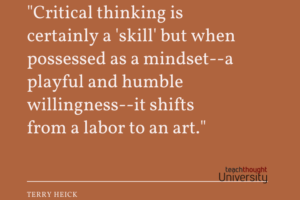
From Theory to Practice: How AI Is Quietly Reshaping College Admissions
By: Ashish Fernando
Higher education is experiencing a paradigm shift. Institutions are now looking at AI-powered solutions as a viable property to streamline operations, engage students better, and boost enrollments. The change in attitude is a visible sign that AI is quietly reshaping college admissions and helping them power through a dry phase of the enrollment crisis.
The enrollment crisis has become a sore point for universities in the last decade, witnessing a consistent decline. Recent studies suggest that it has not stopped even after Covid days. Hence, higher-ed institutions are outgrowing primitive notions and accepting technologies with open arms that help them serve students better and more effectively.
How AI Is Changing the Student Application Experience
AI is transforming the student application experience in more ways than one. Nowadays, universities are making fine adjustments to allow & embolden them to submit video essays, portfolio walkthroughs, or personal testimonials via multimedia formats.
Universities are breaking out of an insular admissions process and making room for new changes.
Apart from the traditional evaluation parameters, allowing students to submit video essays and personal introductions helps universities assess overall personality, communication & speaking skills, and spontaneity.
Allowing students to freely express themselves and showcase their portfolio & creativity is a pivotal yardstick that makes the entire evaluation process more holistic, free-flowing, & democratic.
AI tools such as Natural Language Processing (NLP), sentiment analysis, and facial expression recognition make the process even smoother & faster. They equip universities to screen candidates efficiently and select the best ones for their campuses.
By enabling such changes in the admissions process, universities promote equitable opportunities for students who might perform exceptionally well in the traditional indexes but still have a shot due to an inclusionary change.
However, AI’s role is not only limited to evaluations. Universities are also optimizing AI solutions to encourage, nudge, and assist students in completing their applications. Tools like chatbots, predictive nudges, and automated status alerts help students with personalized guidance and support.
These tools give students quick, real-time feedback, issue an alarming message if they miss attaching critical documents, and also reduce applicants’ anxiety. This helps increase the volume of completed applications without any mistakes, ensuring that applications are not rejected on the basis of half-baked responses or missed-out details.
AI-powered feedback loops bolter application completion rates, enabling universities to conduct a holistic assessment and students to submit their applications in a timely manner.
While application completion rates matter a lot to universities, there is also a calibrated effort to ensure a just and fair admissions process. International admissions from non-traditional backgrounds are increasing on a year-on-year basis.
Therefore, universities are deploying AI-powered review systems which can evaluate and oversee potential in regionally diverse transcripts, non-conventional schooling systems, or life experience narratives.
It allows universities to analyze context and understand a candidate’s background, such as school quality, course availability, and past work experience. Deploying AI tools in this direction can help universities identify obvious signals of grit, creativity, or leadership and eliminate bias from over-reliance on standardized tests.
Universities Keeping up with New Times: Experimenting with AI in Document Processing
Streamlining operations includes automating transcript evaluations. Universities are at the receiving end of millions of student applications during intake seasons and manually reviewing each is quite an uphill task.
Adding to that, if universities do not send immediate responses & status updates to students, they are at risk of losing prospective admissions.
To solve this perennial problem, universities are relying on AI-centric solutions to process documents with an expectation of faster turnarounds and detailed accuracy to meet student expectations.
Although AI solutions are catering to selective operational avenues, they are showing great accuracy & agility in parsing structured academic data in transcripts.
Most universities are using them to parse test scores (SAT, ACT, GRE, TOEFL, IELTS, GMAT), GPA (Cumulative and Term-wise), course titles, grades and credit hours. Some tools have shown resilience in automating highly complex tasks such as credit transfer evaluation, which takes multiple weeks to close by enrollment teams.
Although the utility of AI solutions is not only limited to transcripts, some universities are taking a bold step and optimizing AI tools to review Essays, SOPs, LORs, and Work Experience letters to judge a candidate’s competency leaving no room for human inaccuracy, bias or miss.
AI tools are being effectively used to deliver results in a bound manner and satisfy student needs.
While student applications for undergraduate admissions are still manageable, postgraduate applications are not. With universities making it compulsory for students to submit 3-4 essays, 2-3 LORs or SOPs, and work experience mandatory for specific courses, it becomes a tedious process for enrollment teams to go through each application with equal precision. Here, AI plays a pivotal role in evaluating and rating submissions and helping them select the best candidates.
Most universities resort to structured formats and traditional modus operandi while evaluating candidates. Hence, most AI tools have been built to cater to those needs. Nonetheless, they are also capable of assessing video essays or interviews, allowing candidates to communicate more openly and letting universities evaluate them on benchmarks other than their grades.
Handling Flux of College Applications: Personalizing Interactions with Students
Colleges entertain millions of applications, with each student craving personal attention and rapid communication. With budget cuts and smaller teams, it’s nearly possible to give each student the right amount of attention they need.
Using AI-centric communication tools helps universities in this objective. They guide students through each step of the enrollment funnel and nudge students to take the appropriate actions to make decisions that they are thankful for.
Not only that, AI solutions reduce the workload of enrollment teams by automating responses to student queries within a few seconds, which is also available all the time.
Most of them also have Natural Language Processing (NLP), equipping them to engage in the most human-like way possible. It enables students to develop a sense of clarity and helps them make well-informed decisions.
By attending to student queries and personalizing communication with them, AI solutions help universities garner data insights about the stack board of student questions, boosting engagement rates, increasing enrollments and helping them serve prospective students.
What Does an AI-Generated Report Look Like?
In the ambit of candidate assessment and zeroing down admissions, an AI-generated report is usually an eclectic one. It contains a wholesome evaluation of key performance areas and metrics like skill-based descriptions, confidence scores, profile summaries, academic analysis, test score benchmarking, recommendation sentiments, and essay insights, among other important parameters.
It is actually a vision board for enrollment teams who can decide whether to select, reject or waitlist a sea of candidates with minimal human effort requirements.
However, many think that AI will replace humans and render them jobless.
It’s a common misconception that AI exponents support the erasure of humans from the process. On the contrary, humans are part and parcel of the process- both as a decision-maker and a quality control mechanism. While AI automates routine tasks, only humans can deduce outputs meaningfully, contextualize complexity, and ensure fairness in the overall process.
Last but not the least
Artificial Intelligence is no longer an alien concept in college admissions—it is a pragmatic and sound approach quietly redefining how institutions attract, evaluate, and enroll students. It should not be seen as a replacement of humans; but as a catalyst of change to simplify admissions, help universities overhaul operations and aid students to make wise choices.
It is also very telling of the change in the mindset of universities. Initially showing off a reluctant attitude, universities are now mastering and optimizing AI-centric solutions in different operational areas for data collection, document processing, student engagement, etc, for better outcomes and faster results.
From personalized outreach and predictive modeling to application review and student support, AI enables universities to make more data-informed, efficient, and equitable decisions. By automating routine tasks and surfacing actionable insights, it empowers admissions teams to focus on what matters most: building diverse, successful student cohorts aligned with institutional goals.
Ashish Fernando is the Founder and CEO of EDMO & iSchoolConnect, companies focused on revolutionizing student admissions with AI-driven solutions. Passionate about education, Ashish aims to bridge the gap between education and the workforce. With a background in leadership and entrepreneurship, he emphasizes the importance of action over perfection and strategic focus in creating real-world success.
Source link



